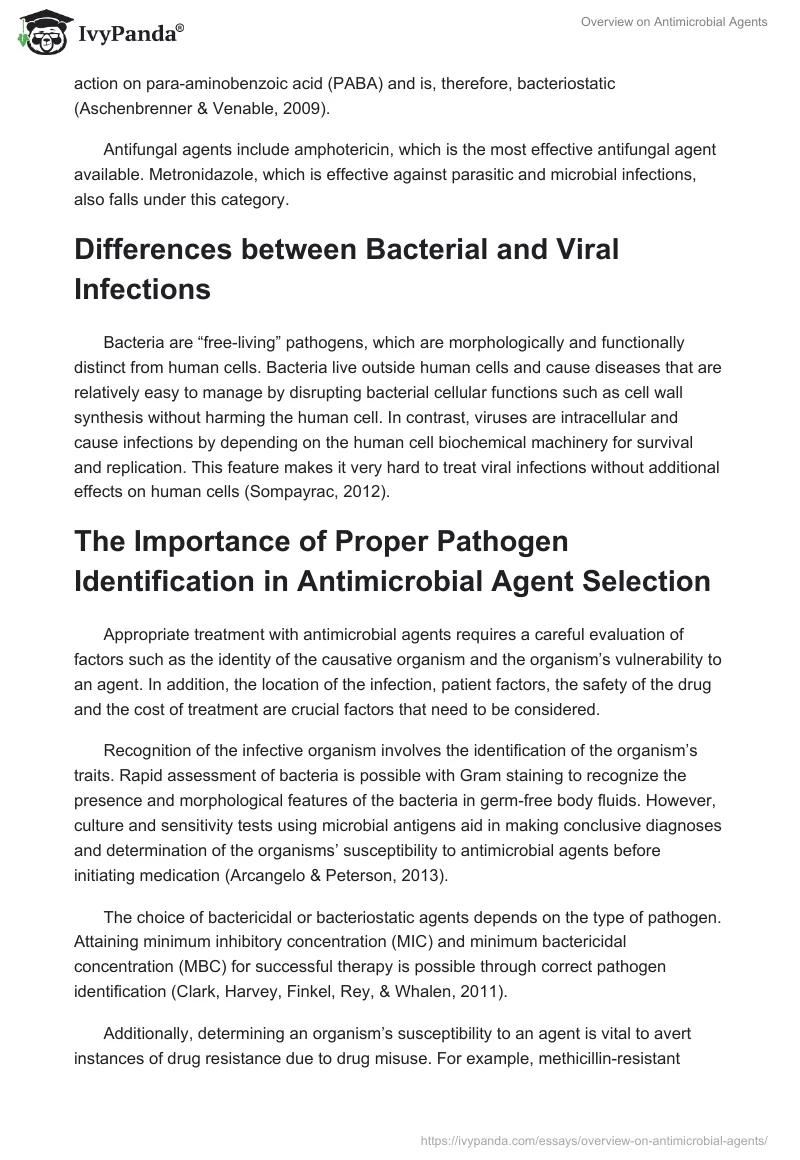Introduction
Antimicrobial agents refer to drugs that act against microbes. The broad classes of antimicrobial agents are antiviral, antifungal, anti-parasitic and antibacterial agents. This paper looks at the classification and mode of action of antimicrobial agents.
Classification of Antimicrobial Agents
Classification of antimicrobial agents is based on the type of microorganism that the agents are effective against, their mode of action and the magnitude of susceptible organisms. Narrow spectrum antimicrobial agents cover a limited range of organisms while broad-spectrum antimicrobial agents destroy a wide range of microbes (Lehne, 2013). Antibiotics are effective against bacteria while antifungals aim at destroying fungi. Conversely, antivirals destroy viruses. Antibiotics can further be grouped into bactericidal antibiotics (they kill bacteria) and bacteriostatic antibiotics (work by slowing down bacterial growth).
Bactericidal agents include various classes of drugs namely penicillins, cephalosporins, aminoglycosides, fluoroquinolones, and metronidazole. Bacteriostatic agents, conversely, consist of macrolides, tetracyclines, trimethoprim, and sulfonamides. Penicillins and cephalosporins act against the β-lactam ring in the cell wall of Gram-positive bacteria (Lehne, 2013). These antibiotics inhibit cell wall formation by binding to penicillin-binding proteins (PBPs). Consequently, these drugs prevent peptidoglycan formation of the external membrane in Gram-positive bacteria and the interior membrane of Gram-negative bacteria.
Aminoglycosides such as gentamycin are operational against all enterobacteria (Aschenbrenner & Venable, 2009). Bacteriostatic agents consist of macrolides and tetracyclines that function through inhibiting protein synthesis by targeting the 30s and 50s subunits of ribosomes, hence limiting bacterial growth. Sulphonamides aim at folate synthesis and limit bacterial growth, but do not kill the microorganisms. Trimethoprim, in a synergistic combination with sulfamethoxazole, stops DNA synthesis through its action on para-aminobenzoic acid (PABA) and is, therefore, bacteriostatic (Aschenbrenner & Venable, 2009).
Antifungal agents include amphotericin, which is the most effective antifungal agent available. Metronidazole, which is effective against parasitic and microbial infections, also falls under this category.
Differences between Bacterial and Viral Infections
Bacteria are “free-living” pathogens, which are morphologically and functionally distinct from human cells. Bacteria live outside human cells and cause diseases that are relatively easy to manage by disrupting bacterial cellular functions such as cell wall synthesis without harming the human cell. In contrast, viruses are intracellular and cause infections by depending on the human cell biochemical machinery for survival and replication. This feature makes it very hard to treat viral infections without additional effects on human cells (Sompayrac, 2012).
The Importance of Proper Pathogen Identification in Antimicrobial Agent Selection
Appropriate treatment with antimicrobial agents requires a careful evaluation of factors such as the identity of the causative organism and the organism’s vulnerability to an agent. In addition, the location of the infection, patient factors, the safety of the drug and the cost of treatment are crucial factors that need to be considered.
Recognition of the infective organism involves the identification of the organism’s traits. Rapid assessment of bacteria is possible with Gram staining to recognize the presence and morphological features of the bacteria in germ-free body fluids. However, culture and sensitivity tests using microbial antigens aid in making conclusive diagnoses and determination of the organisms’ susceptibility to antimicrobial agents before initiating medication (Arcangelo & Peterson, 2013).
The choice of bactericidal or bacteriostatic agents depends on the type of pathogen. Attaining minimum inhibitory concentration (MIC) and minimum bactericidal concentration (MBC) for successful therapy is possible through correct pathogen identification (Clark, Harvey, Finkel, Rey, & Whalen, 2011).
Additionally, determining an organism’s susceptibility to an agent is vital to avert instances of drug resistance due to drug misuse. For example, methicillin-resistant Staphylococcus aureus (MRSA) is resistant to penicillins. Therefore, accurate diagnosis helps in the proper management of the microbe with drugs such as tetracycline and clindamycin.
In viral infections, medication is relatively difficult as long-term use of antiviral drugs has grave side effects. Viruses have complex structures because they frequently mutate. Therefore, no “broad-spectrum antiviral drugs” are available. Viral infections pose great dangers during viral attacks hence require proper identification before the initiation of treatment (Sompayrac, 2012).
Conclusion
The success of antimicrobial agents depends on the correct identification of the disease-causing microorganism. Therefore, nurse practitioners need to be cautious in the diagnosis of microbial infections.
References
Arcangelo, V., & Peterson, A. (2013). Pharmacotherapeutics for advanced practice: A practical approach (3rd ed.). Ambler, PA: Lippincott Williams & Wilkins. Web.
Aschenbrenner, D., S. & Venable, S. J. (2009). Drug therapy in nursing. Philadelphia: Lippincott Williams & Wilkins. Web.
Clark, M. A., Harvey, R. A., Finkel R., Rey, J. A., & Whalen, K. (2011). Pharmacology. Philadelphia: Lippincott Williams & Wilkins. Web.
Lehne, A. R. (2013). Pharmacology for nursing care (8th ed.). Philadelphia: Saunders Publishers. Web.
Sompayrac, L. (2012). How pathogenic viruses think. Boston: Jones & Bartlett Publishers. Web.


